Mink Oil
The North American mink (Neovison vison) – previously classified as Mustela vison – was one of many animal species trapped for its fur and then later farmed in the United States, Canada, Europe and elsewhere.
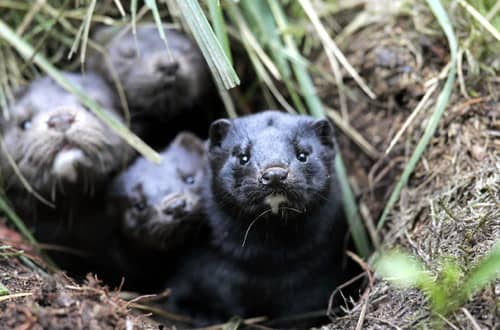
Above: Minks.
Mink oil is a byproduct of ranch mink produced from the fat removed from the skinned pelt. The rendered oil is then purified, bleached and deodorised. The widespread use of mink oil in cosmetics does not appear to have occurred until the 1960s. The reason for this has more to do with fashion than any other factor.
Although fur was widely worn in colder climates, the preference was not necessarily for mink. For example, Hollywood film stars between the two world wars wore a lot of fur but preferred fox or sable. It would not be until the end of the 1930s that fashion would begin to switch to mink (Dyhouse, 2010, p. 37). When the demand for mink rose after the Second World War the supply of ranch mink increased, so too did the byproducts from the trade including oil derived from mink fat. Two main uses were found for this oil, leather treatments and cosmetics, both of which had a history of incorporating animal fats into their products.
Cosmetics
Stendhal, Paris, claims to have been the first cosmetic company to use mink oil (l’huile de vison) in 1949. However, they do not appear to have featured it prominently in their cosmetics until the 1960s when their ‘La Ligne de Vison’ (The Mink Line) used mink oil in the formulation of eyeshadows, skin creams, suntan lotions and soap.
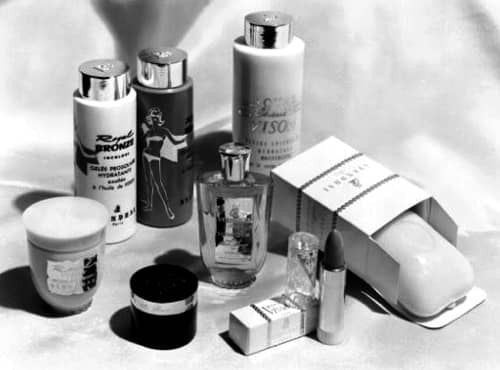
Above: 1962 Stendhal La Ligne de Vison. Products in the range included: Huile Vithelium Vison, mink oil; Royal Bronze, a sunscreen, either tinted or colourless; Savon Vithelium Vison, a mink oil soap; Creme Vithelium Vison, mink cream; and Baton-Paupières, a stick eyeshadow in 9 colours and 6 iridescent shades.
By this time other French companies, such as Cedib, Klytia and Innoxa, were also making cosmetics containing mink oil and there was some interest elsewhere including Britain and the United States.
An early American promoter of mink oil cosmetics was the department store R. H. Macy and Co. According to Stabile they introduced a mink oil cream in 1951. Worried that women might think mink oil would create fur on their face Macy’s promoted it primarily as a hand cream, although the label referred to it as an all-purpose cream. It did not sell well, even when heavily discounted (Stabile, 1969, p. 104).
Composition
Fenonjois notes that some work was done on mink oil in Germany in 1935 but the first detailed study was not undertaken until 1955 when Dr. John M. Cross at the Rutgers College of Pharmacy, New Jersey investigated its potential use in cosmetics including perfumes (Fenonjois, 1960, p. 965). Word about his research was reported in a number of American newspapers in the late 1950s and was eventually noted by the American Perfumer & Essential Oil Review in 1958.
Dr. John M. Cross, professor of pharmaceutical chemistry in Rutgers College of Pharmacy who has been conducting research on oil derived from mink fat reports that mink oil may be useful in skin softening creams and may have uses in perfume. Gray white mink suet is so easily renderable that body heat turns it into a clear yellow oil. It is reported that the Rutgers scientists are probing for an obvious hormone content. All of its properties are being checked and rechecked in the laboratories. Already four companies in the cosmetic field have been experimenting with it. According to reports Dr. Cross declared that mink get a good diet of ground beef, vitamins and cod liver oil during their six months life on mink ranches. There are only four or five ounces of fat on the average two-pound mink and it is estimated that 350 tons of rendered oil a year might be produced from mink fat throughout the country. Mink oil incidentally is quoted at $6 per trial pound and in lots under 100 lbs. at $4.
(AP&EOR, May 1958, p. 10)
Cross failed to find a hormone or any other compound that would give mink oil extraordinary properties. However, as with many other biological ingredients added to cosmetics in the 1950s – such as royal jelly and placental creams – the story surrounding the ingredient was more important than the science.
See also: Royal Jelly and Placental Creams and Serums
When Cross’s work was reported in the newspapers it invariably mentioned that mink farmers who killed and skinned minks ‘suffered’ from soft hands.
Dr. Cross got on the scent of the “moneyed smell” when a New Jersey mink rancher complained that his hands became soft from skinning the animals. The rancher’s wife referred the problem to a pharmacist, who told Dr. Cross.
(The Hopewell News, November 7 1956. p. 6)
This ‘mink-skinner’ story was repeated by Fenonjois in her article for SPC, although modified slightly to single out mink fat as the beneficial material.
For some time past, the employees who prepare the skins and at the same time handle the underlying fat, have found that this fat had a spectacular softening effect on the hands. Beauty experts who heard of this phenomenon, at once advocated the use of this fat for cosmetic purposes, thus giving rise not only to immediate uses but also to work of a dermatological nature.
(Fenonjois, 1960, p. 965)
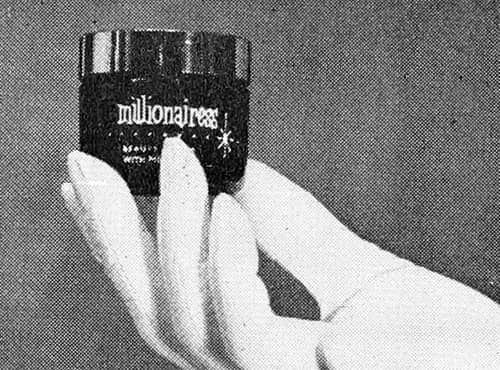
Above: 1961 Millionairess Beauty Cream. This British beauty cream contained mink oil sourced from France.
Later research into the composition of mink oil failed to find any ‘miracle ingredient’ and justifications for using mink oil in preference to vegetable or mineral oils remain very weak. However, this did not stop mink oil from finding its way into a number of cosmetics including skin creams, hair conditioners, bath oils, nail conditioners and mascaras. Two sample recipes for products using mink oil are given below:
Cold cream
g. Propylene glycol monostearate 6.5 Mink oil (4%) 4.0 Mineral oil 24.0 Triethanolamine 1.5 Water 64.0 Odor (perfume) q.s. 100.0 Warm all ingredients except the perfume in a glass or porcelain container at 70°C. Remove from heat and stir until the mixture is almost at room temperature. Incorporate perfume and stir until cool. The mink oil may be varied from 1% to 15% by replacing an equal quantity of mineral oil.
(US patent: 2954325, 1960)
Hand lotion
g. Propylene glycol monostearate 2.0 Mink oil 3.0 Stearic acid 6.0 Triethanolamine 1.0 Glycerin 3.0 Water 85.0 Perfume q.s. 100.0 Mix and warm all ingredients to 70°-80°C. Stir the melted mixture until cool. Add perfume if desired. The mink oil may be varied from 1% to 15% in this preparation.
(US patent: 2954325, 1960)
Mink and glamour
Since mink oil had no specific advantages over other oils and the amounts used in cosmetics could be as low as 1% of the formulation, most of the benefits gained by adding mink oil to a cosmetic were through associating the product with the prestige of mink fur.
OK— but once again, why mink? Of course, we can agree that its mere presence on label ingredient lists (now required on all new cosmetics) will add a distinct touch of glamour to a product, implying “class” and obviating the need for specific claims. This alone can be quite an advantage these days when the FTC is demanding more and more laborious justification of all product claims.
(Goldemberg, 1974, p. 46)
The connection between mink and glamour – as epitomised by the Blackglama mink advertising campaign begun by the Great Lakes Mink Association (GLMA) in 1968 – was an important selling point for many mink oil cosmetics.
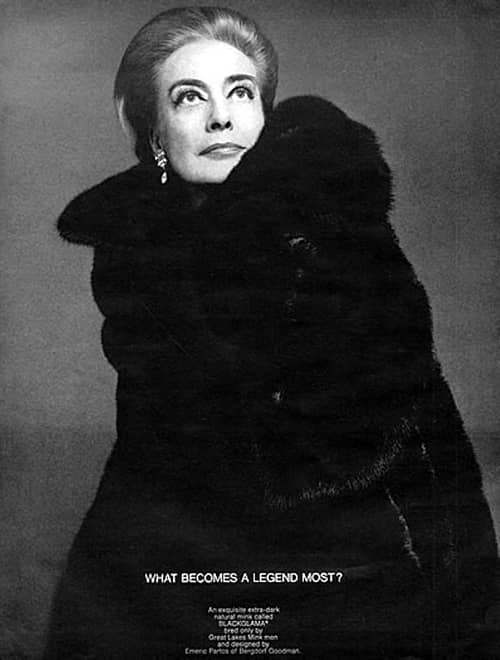
Above: 1969 Blackglama advertisement featuring Joan Crawford.
Later advertising for these products frequently included models wrapped in mink fur to ensure the customer got the connection. In many ways this made mink oil cosmetics ideally suited to the glamour, materialism and privilege of the 1970s and 1980s and this is when they had their greatest appeal. However, this appeal was limited and, as far as I can tell, none of the major cosmetic houses became involved in its use.
As fur fell out of fashion – in part through anti-fur activism – mink oil lost its most important advertising strength. Today, most cosmetic companies avoid the odium associated with using animal extracts, preferring plants instead. However, mink oil has not disappeared. Cosmetic grades of the oil and mink oil cosmetics are still available from a number of companies.
Updated: 13th August 2018
Sources
The American perfumer & essential oil review. (1906-1955). New York: Robbins Perfumer Co. [etc.].
Dyhouse, C. (2010). Glamour: Women sex and feminism. London: Zed Books.
Fenonjois, E. (1960). Mink oil in cosmetics. Soap, Perfumes and Cosmetics , September, 965-966.
Goldemberg, R. L. (1974). Mink oil a reevaluation. Drugs & Cosmetics Industry, February, 46-49, 138-139.
Stabile, T. (1969). Cosmetics: Trick or treat? (3rd ed.). New York: Arco Publishing Company, Inc.
Tobias, A. (1972). Do you seriously want to give Glenn Turner your money? New York Magazine, February 28, 27-34.
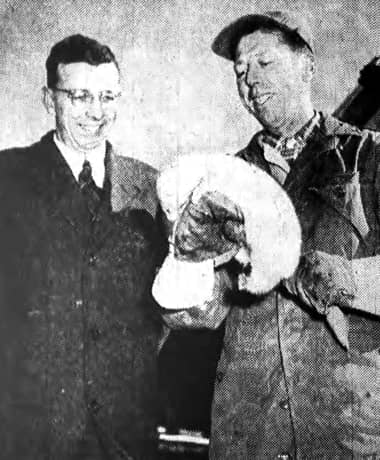
1956 “Dr. John M. Cross, left, son of Mr. and Mrs. Robert Cross of Second Avenue, meets a frisky Winterblue mink at Art Le Bailly’s ranch near New Brunswick. Dr. Cross, a Rutgers University pharmacy professor, is studying the possibilities of using mink oil as a perfume base” (Little Falls Herald, August 30 1956. p. 4).
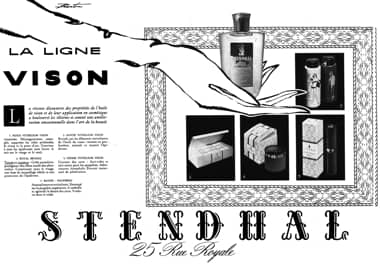
1962 Stendhal La Ligne Vison.
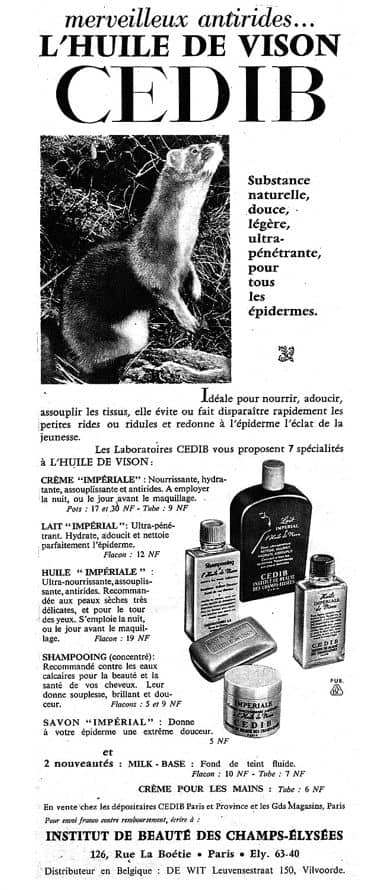
1962 Cedib Crème Impériale, Lait Impériale, Huile Impériale, Shampooing and Savon Impériale with mink oil.
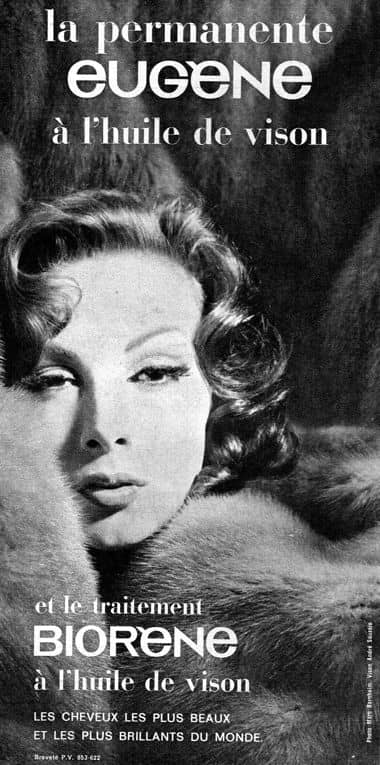
1962 Eugène Hair Colour with mink oil.
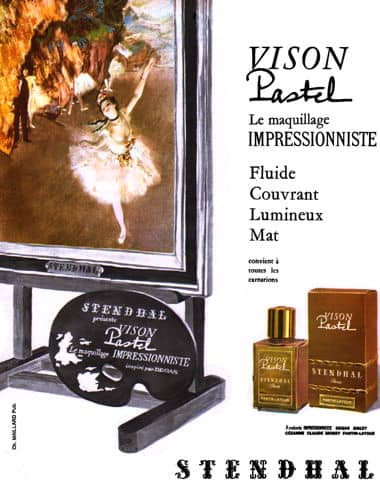
1965 Stendhal Vison Pastel.
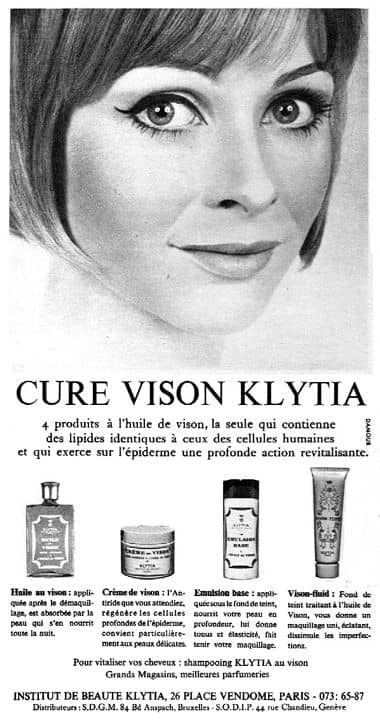
1965 Klytia Huile au Vison, Crème de Vison, Emulsion Base, and Vison-fluid.
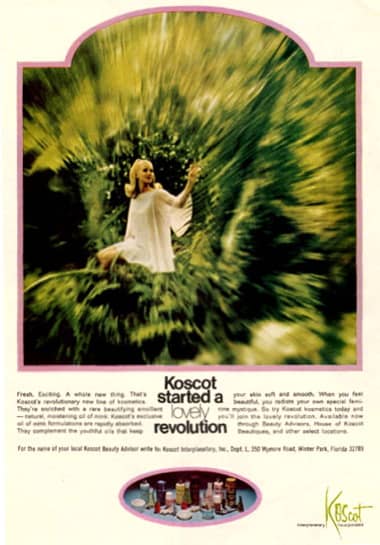
1969 Koscot Interplanetary cosmetics with mink oil. Koscot was established by Glenn W. Turner in 1967, selling a range of mink oil cosmetics. It went into bankruptcy in 1973 following court cases which alleged that the business was a pyramid selling scheme.
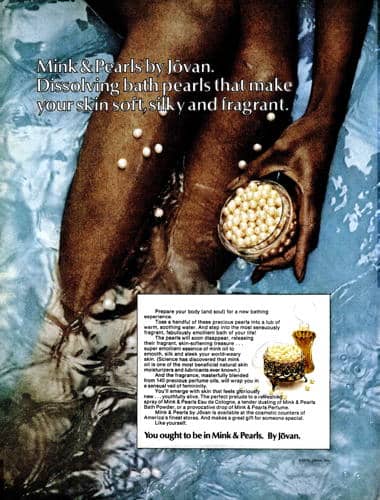
1976 Jōvan ‘Mink & Pearls’ Bath Pearls with mink oil.
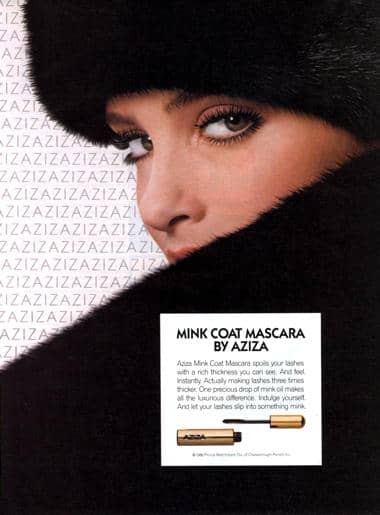
1986 Aziza Mink Coat Mascara with mink oil.
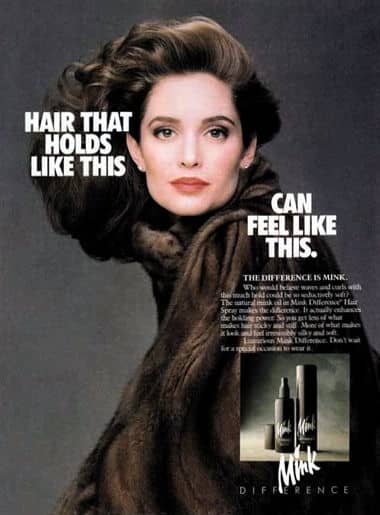
1989 Gillette Mink Difference Styling Collection with mink oil.

1991 Raveen Oil Sheen and Conditioner. Mink oil was found in a number of hair-care lines aimed at the African American market.
